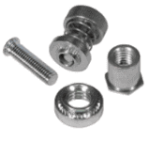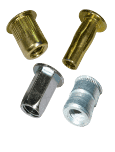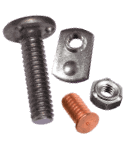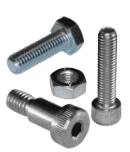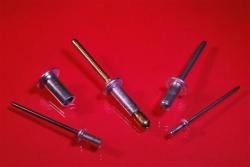Rivets
There are numerous types of rivets that are available in today’s market. However, most consist of a head on one end and a specifically sized cylindrical body that extends to the rivet’s tail. Solid rivets, semi-tubular and breakstem rivets (POP® rivet style) are generally placed within a pre-punched or pre-drilled hole. At that point, solid and semi-tubular rivets are deformed by the use of a bucking bar or solid anvil (semi-tubular only) strategically placed opposite the head side of the rivet while a press or air hammer. The blind (breakstem) rivet is also used in a pre-punched or pre-drilled hole but the setting process is different. Once the rivet body has been placed in the hole, the mandrel or “stem” (also called a nail) is then inserted into the nosepiece of a rivet gun or manual rivet tool. Rivets of a variety of materials (aluminum, steel, stainless steel, copper, plastic) are commonly used to join two pieces of material together within a wide range of applications including boat building, RV manufacturing, industrial fabrications and more.
Contact us for more information regarding our numerous types of rivets including solid rivets, blind breakstem rivets (POP® rivet style), semi-tubular rivets and more. Or call us at 1-800-783-0910 with any questions that you may have.
Advanced Quality Blind Rivets
Blind breakstem rivets are extremely popular because they install easily and can produce super strong structural bonds. Blind rivets can be completely installed from one side of the material that is being utilized riveted. This provides significant benefits over machine screws and nuts that require access to both sides of the material. A blind rivet consists of two pre-assembled pieces, the rivet body and mandrel. Some of the different types of blind rivets that we offer include:
The Blind Rivet Manufacturing Process
Rivets are manufactured with a head on the end of a round hollow shaft in a wide variety of designs and sizes. During installation, the tail end expands to create a second “head”. Which provides the strength required to secure the two pieces of material together. Choosing the rivets that work for your specific application is determined by a variety of factors but here are a few important features to consider:
• Length and diameter of rivet needed
• Space limitations
• Load and shear values
• Installation tools
• Host material
• Choice of head design
How to Install a Blind Rivet
Installing a blind rivet is safe, easy and effective. There are only a few simple steps that need to be followed to successfully install a blind rivet. The subsequent steps should be followed in proper order when installing a blind rivet:
1. Insert the rivet into the pre-determined hole that will be joining the items.
2. Insert the mandrel (skinny body) into the rivet gun or tool.
3. Set the rivet in place by firing the gun or tool that is holding the mandrel.
Once the above procedure is completed the mandrel will break off inside the rivet tool, leaving only the intact rivet that has joined the two objects.
Blind Rivet Applications
Depending on your specific needs, blind rivets can be used for a wide range of applications. Some of the most common uses for blind rivets include:
• Attaching steel, aluminum, stainless steel, plastic and even wood materials together
• Attaching hinges
• Automotive manufacturing
• Aircraft manufacturing
• Contract manufacturing
• Sheet metal fabricating
• Trailer repair
• Boat repair
Solid Rivets & Semi-Tubular Rivets for your Project Needs
Solid and semi-tubular rivets are available with various head designs including universal, round, flat, brazier, and countersunk. The flat head rivet is generally the strongest and most secure. Solid rivets are the oldest, safest, and often the most reliable type of rivet. In addition, most of our fasteners are available in inch or metric measurements, with various material and aesthetic finishing options. Tubular rivets are usually used in applications where there is a need of extra safety and reliability as well as a low profile. Some of the applications that commonly use solid rivets and semi-tubular rivets include:
• Ladders
• Ladders
• Lighting
• Brakes
• Binders
• Aircraft
• Trains
• Boats
Rivet Installation Tools
Monroe JHP Fasteners offers a large selection of new installation tooling for rivets and other fasteners. We stock high quality, high-performance equipment for a broad range of fastening applications. Our inventory includes:
Contact Monroe JHP Fasteners Today for All Your Rivet Needs
Monroe JHP Fasteners is a leading distributor of all types of fasteners used by precision sheet metal fabricators. Contact us for help in choosing the correct rivets for your application needs. Request a Quote for solid rivets, blind rivets or semi tubular rivets from Monroe JHP Fasteners today!



